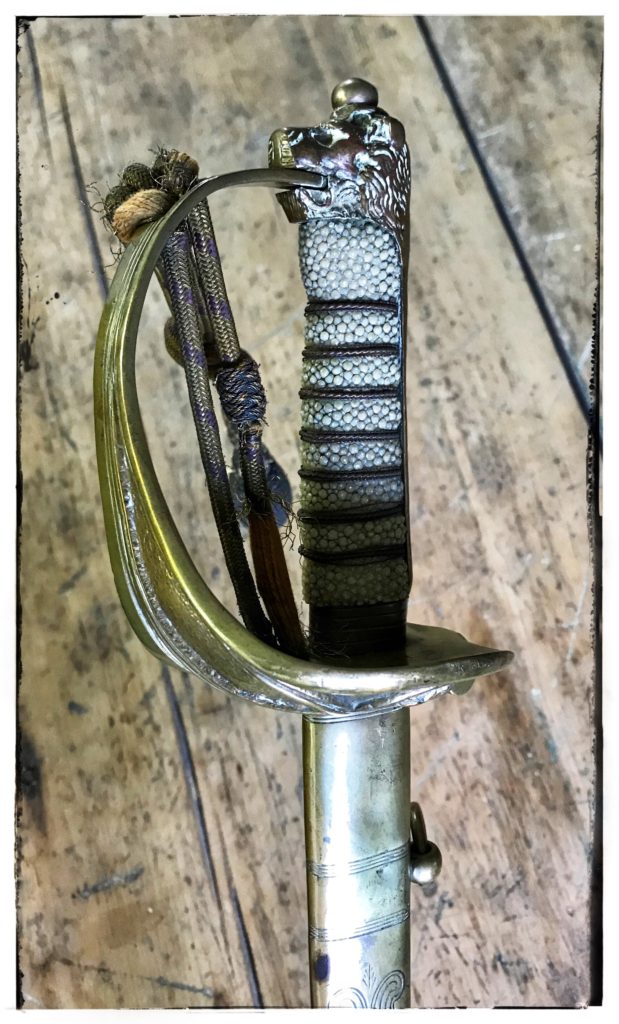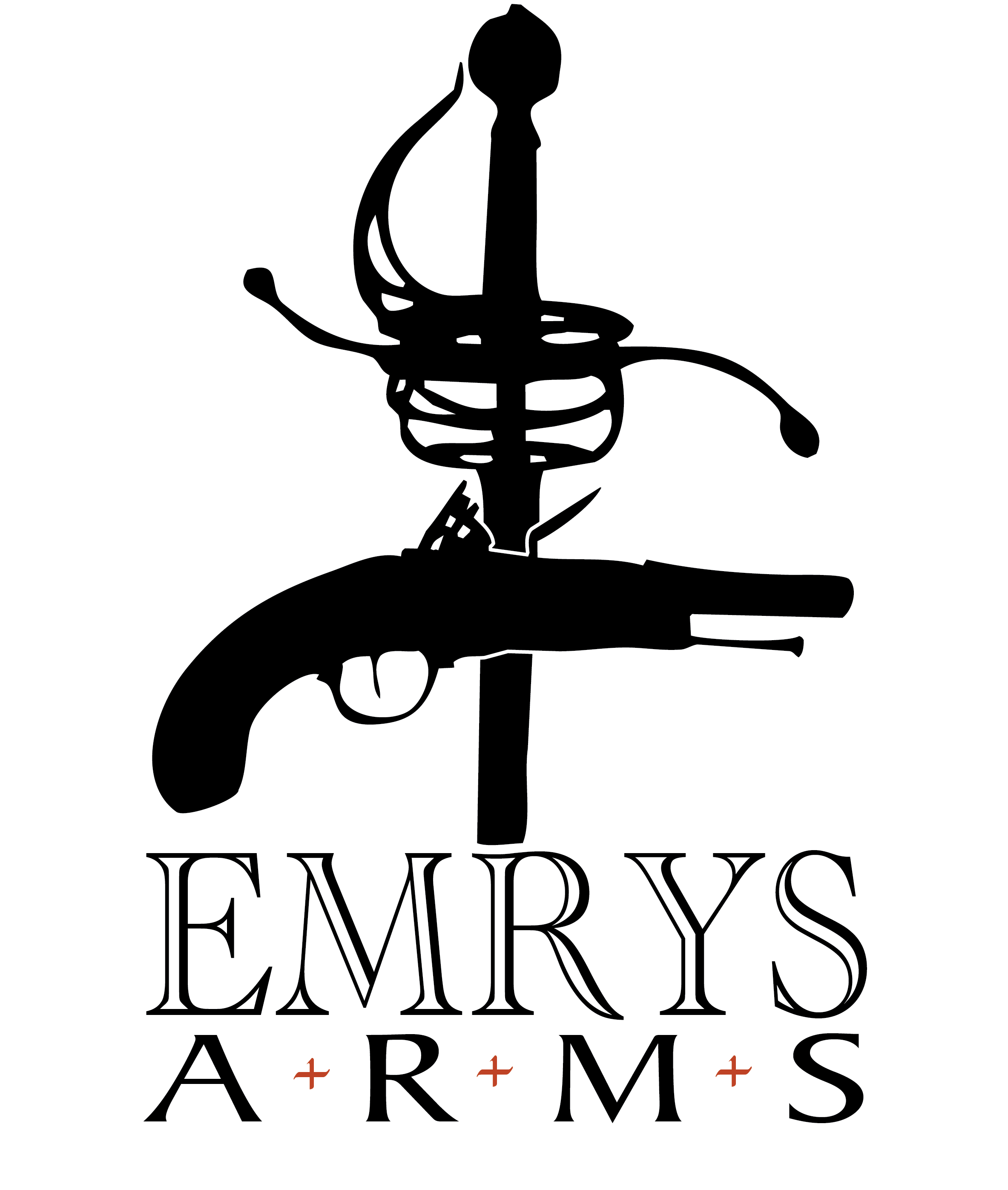| Collection #: | 2020.018 |
|---|---|
| Type: | Naval Officer (Captain or below) |
| Nationality: | British |
| Pattern: | 1827/46 |
| Date: | 1907 - 1929 |
| Hilt: | Brass |
| Blade Length: | 78.8cm (31.02") |
| Blade Width: | 2.5cm (1") |
| Overall Length: | 94cm (37") |
| Maker: | Kenning & Son, London Liverpool Manchester Glasgow |

With the introduction of the 1827 pattern, we see the beginning of the end of the development in the officers’ sword for sea service. By that I mean we are presented with the hilt style which is still in use to this day, outside of some mild decorative details. Interestingly, when you compare the Naval Officers’ Pattern 1827 with the Infantry Officers’ Pattern 1822, you will find them to have the same basket hilt guard with the exception that the Naval Officers’ guard is solid and contains a crowned fouled anchor (or some variation of) instead of the Royal Cypher. As well, the Naval officers sword has a lion head pommel / backstrap versus the stepped pommel of the Infantry version. However, the stepped pommel was retained in the navy for “warrant officers and masters-at-arms when the flat-backed blade was introduced [1846]” (British Naval Swords & Swordsmanship, page 48) discussed further with sword 2020.059.
The major difference from the original Pattern 1827 to todays version, is the style of blade. “The Army replaced the thoroughly unsatisfactory pipe-backed blade with the Wilkinson designed flat backed blade in 1845 after twenty-three years of service and the Royal Navy made the change a year later after suffering from this inadequate weapon for nineteen years. Today’s swords remain substantially the same as those resulting from this change.”
The grip of white fish skin is in immaculate condition with wire binding present (two slightly loose secondary wire bands). The brass guard, lion head pommel and backstrap are pleasantly worn with traces of old polish in the cracks, still to be removed. The blade, grip and guard construction are still tight with no loose movement. Present with this sword is the sword knot.
As a student of antique arms, you may ask ‘what is a sword knot?’ and ‘where does it originate?’ well, thankfully Brian Robson, and possibly many others have answered that for us. He relates “in the shock of combat a sword could be easily knocked out of, or could fall from, the user’s hand. The original purpose of a sword knot was therefore to attach the sword to the user’s wrist so that even if the sword was knocked out of his hand he could still retrieve it. In the course of time, this practical purpose gradually lost its importance, and the sword knot is now purely an ornament”.
Sword knots themselves went through an evolution and can also help us to date the sword.
I would like to say that this single fullered, Wilkinson style blade is in very good condition, and 95% of it is, however, due to some damage that the scabbard has sustained, the blade has also sustained some corrosive damage in the corresponding area. The right side of the blade contains the Star of David (often used by Wilkinson) with a brass proof slug marked PROVED stamped into the slug. It is then followed by the Royal Coat of Arms and then a blank era normally reserved for etching of the owners initials. After that, some floral decoration followed by a crowned fouled anchor and concluding with the same floral pattern. The left side of the blade begins with the retailers mark on the ricasso. This particular sword was retailed by KENNING & SON LONDON LIVERPOOL MANCHESTER GLASGOW. Along with the sword knot and style of blade, this retailer mark will be another clue for us in dating the time period of this sword. After the retailer markings, the blade decoration replicates that of the right side.
The black leather scabbard with brass fittings has done its job for the most part in protecting the blade. It is intact with no bends; locket, middle band, chape and loose rings all present. The only flaw being two holes where something has rubbed or chewed through the leather. The first smaller one at 13.5cm and the larger 18cm down from the mouthpiece. One thing to be aware of if you come across one of these swords (so that you do not accidentally damage it) is the locking mechanism. On the backside of the scabbard locket is a small stud which inserts into the folding guard. When the sword is in the scabbard with the folding guard down, it will not extract no matter how hard you pull on it and you will damage it. Always remember if the obvious does not happen (easily pulling sword from scabbard) investigate before applying brute force!
So for a pattern of sword that has been in use for almost 200 years, how do we narrow down its date of manufacture? We know that it has a blade style that was introduced in 1846. Kenning & Son operated under this name in three of the four locations ( Manchester – I was unable to find a listing for their time at that location) from as early as 1885 (up to 1907, however provincial directories were not always updated regularly) until 1954 -1958, (May & Annis, Swords for Sea Service, Vol 2). The style of sword knot is the pattern introduced in 1891 (McGrath & Barton, British Naval Swords & Swordsmanship, page 49), granted it could have been added to an earlier constructed sword. We can also say the blade was made no later than 1929, at which time the blade width was reduced to between 16mm and 21mm (McGrath & Barton, British Naval Swords & Swordsmanship, page 49). The crown incorporated into the fouled anchor on the guard appears to be a Tudor crown introduced in 1901. I therefor assigned this naval sword a conservative date range of 1907 – 1929, although a slightly earlier construction date (as early as 1901) may be able to be argued.
We use cookies to improve your experience on our site. By using our site, you consent to cookies. Enjoy the cookies...they're delicious...
Websites store cookies to enhance functionality and personalise your experience. You can manage your preferences, but blocking some cookies may impact site performance and services.
Essential cookies enable basic functions and are necessary for the proper function of the website.
Statistics cookies collect information anonymously. This information helps us understand how visitors use our website.
Google Analytics is a powerful tool that tracks and analyzes website traffic for informed marketing decisions.
Service URL: policies.google.com (opens in a new window)

